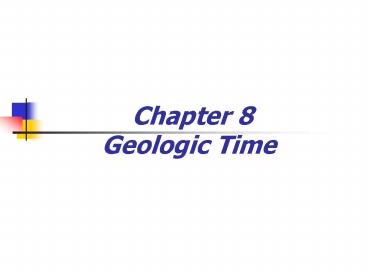Chapter 8 Geologic Time - PowerPoint PPT Presentation
1 / 31
Title:
Chapter 8 Geologic Time
Description:
Chapter 8 Geologic Time Historical Notes Catastrophism Landscape developed by catastrophes James Ussher, mid-1600s, concluded Earth was only a few thousand years old ... – PowerPoint PPT presentation
Number of Views:351
Avg rating:3.0/5.0
Title: Chapter 8 Geologic Time
1
Chapter 8 Geologic Time
2
Historical Notes
- Catastrophism
- Landscape developed by catastrophes
- James Ussher, mid-1600s, concluded Earth was only
a few thousand years old - Abraham Gottlob Werner
- Neptunist
3
Historical Notes
- Modern geology
- Uniformitarianism
- Fundamental principle of geology
- "The present is the key to the past"
- James Hutton Plutonist/Vulcanist
- Theory of the Earth, 1795
- no vestige of a beginning no prospect of an
end - Charles Lyell
- Principles of Geology
- Mentor of Charles Darwin
4
Relative Dating
- Law of superposition
- Developed by Nicolaus Steno in 1669
- In an undeformed sequence of sedimentary rocks
(or layered igneous rocks), the oldest rocks are
on the bottom
5
Superposition Is Well Illustratedby the
Stratain the Grand Canyon
Figure 8.2
6
Relative Dating
- Principle of original horizontality
- Layers of sediment are generally deposited in a
horizontal position - Rock layers that are flat have not been disturbed
- Principle of cross-cutting relationships
- Younger features cut across older features
7
Cross-Cutting Relationships
Figure 8.4
8
Relative Dating
- Inclusions
- An inclusion is a piece of rock that is enclosed
within another rock - Rock containing the inclusion is younger
- Unconformity
- An unconformity is a break in the rock record
produced by erosion and/or nondeposition of rock
units
9
Angular unconformity Tilted rocks are overlain
by flat-lying rocks
10
Disconformity Strata on either side of the
unconformity are parallel
11
Nonconformity
Metamorphic or igneous rocks in contact with
sedimentary strata
12
Grand Canyon
13
Fossils Evidence of Past Life
- Fossil traces or remains of prehistoric life
now preserved in rock - Fossils are generally found in sediment or
sedimentary rock (rarely in metamorphic and never
in igneous rock) - Paleontology study of fossils
14
Fossils Evidence of Past Life
- Geologically fossils are important because they
- Aid in interpretation of the geologic past
- Serve as important time indicators
- Allow for correlation of rocks from different
places
15
Fossils Evidence of Past Life
- Conditions favoring preservation
- Rapid burial
- Possession of hard parts (skeleton, shell, etc.)
16
Fossils Evidence of Past Life
17
Dinosaur Footprint in Limestone
18
Fossils and Correlation
- Matching of rocks of similar ages in different
regions is known as correlation - Correlation often relies upon fossils
- William Smith (late 1700s) noted that sedimentary
strata in widely separated area could be
identified and correlated by their distinctive
fossil content
19
Fossils and Correlation
- Principle of fossil successionFossil organisms
succeed one another in a definite and
determinable order, and therefore any time period
can be recognized by its fossil content - Index fossilGeographically widespread fossil
that is limited to a short span of geologic time
20
Dating Rocks Using Overlapping Fossil Ranges
- Figure 8.10
21
Dating with Radioactivity
- Parent An unstable radioactive isotope
- Daughter productThe isotopes resulting from the
decay of a parent - Half-lifeThe time required for one-half of the
radioactive nuclei in a sample to decay
22
Radioactive Decay Curve
23
Dating with Radioactivity
- Importance of radiometric dating
- Rocks from several localities have been dated at
more than 3 billion years - Confirms the idea that geologic time is immense
24
The Geologic Time Scale
- The geologic time scaleA calendar of Earth
history - Subdivides geologic history into units
- Originally created using relative dates
- Structure of the geologic time scale
- EonThe greatest expanse of time
25
The Geologic Time Scale
- Structure of the geologic time scale
- Names of the eons
- Phanerozoic (visible life)The most recent eon,
began about 540 million years ago - Proterozoic
- Archean
- HadeanThe oldest eon
26
The Geologic Time Scale
- Structure of the geologic time scale
- Precambrian (all of geologic time before the
Paleozoic) - Eras of the Phanerozoic eon
- Cenozoic (recent life)
- Mesozoic (middle life)
- Paleozoic (ancient life)
- Eras are subdivided into periods
27
The Geologic Time Scale
- Precambrian time
- Nearly 4 billion years prior to the Cambrian
period - Not divided into smaller time units because the
events of Precambrian history are not known in
great enough detail - First abundant fossil evidence does not appear
until the beginning of the Cambrian
28
(No Transcript)
29
Paleozoic Time
30
Mesozoic-Cenozoic Time
31
End of Chapter 8































